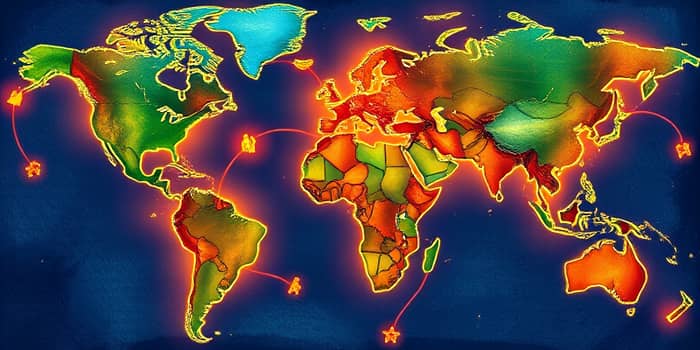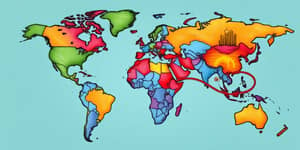
In an era where borders blur under the weight of commerce, regional trade agreements (RTAs) have emerged as powerful conduits linking nations, industries, and communities. By forging strategic partnerships, these pacts are not merely legal documents, but catalysts that breathe life into economies, spark innovation, and weave a tapestry of shared prosperity. As global dynamics shift, understanding how RTAs reshape trade flows becomes essential for policymakers, businesses, and citizens eager to thrive in an interconnected world.
Since the late twentieth century, the number of RTAs has grown at an unprecedented pace. As of May 2025, there are 375 regional trade agreements in force globally, representing a major increase from previous decades. This proliferation reflects a collective desire for closer economic integration, with nations seeking tailored frameworks to lower tariffs, harmonize standards, and foster investment.
Some of the most influential RTAs today include the Regional Comprehensive Economic Partnership (RCEP), which unites ASEAN and six partners in the world’s largest by population and GDP trade bloc, the Comprehensive and Progressive Agreement for Trans-Pacific Partnership (CPTPP) spanning eleven Asia-Pacific nations, the African Continental Free Trade Area (AfCFTA) aimed at knitting together African markets, and the Pacific Alliance linking Chile, Colombia, Mexico, and Peru. Each pact brings unique strengths and ambitions to the global stage.
Global trade reached a record $33 trillion in 2024, marking a 3.7% uptick from the previous year. Services have emerged as a robust pillar, while goods face jittery headwinds amid rising protectionism and geopolitical tensions.
These trends underscore the resilience and flexibility of emerging economies. While traditional powerhouses recalibrate policies, developing nations step up as critical players in both manufacturing and services, driving the next wave of growth.
The shockwaves of recent geopolitical events prompted a reversal of friendshoring and nearshoring trends in 2024, as companies pivot towards diversifying trade networks across regions to reduce risk and complexity. Instead of concentrating production in a handful of locations, businesses are forging multiple partnerships and exploring new markets to safeguard against disruptions.
Countries such as Russia, Vietnam, and India have deepened their ties with key partners, enhancing resilience and capacity. Meanwhile, economies like Australia and the European Union strategically rebalance their dependencies, ensuring supply lines remain secure. This mosaic of alliances transforms traditional value chains into a dynamic web of interactions, with smaller players gaining unprecedented influence.
RTAs wield significant power to reshape trade landscapes, fueling growth through tariff reductions and regulatory alignment. However, they also introduce debates around trade creation versus trade diversion. While member states often enjoy new market access and investment, non-members may lose out, potentially causing inefficiencies in the global system.
Balancing these forces requires thoughtful policy design. Decision-makers must weigh local industry protections against broader efficiency gains, ensuring agreements deliver inclusive prosperity.
Beyond mere economic metrics, RTAs harbor the potential to reshape lives. Projections suggest that RCEP alone could lift 27 million people into middle-class status by 2035, a testament to RTAs as engines of social mobility. Yet, this promise hinges on minimizing exclusions and restrictive rules, such as onerous rules of origin that can stifle small businesses.
To unlock these benefits, member states and stakeholders must prioritize inclusivity—extending capacity-building programs, simplifying customs procedures, and fostering transparent governance. When designed with equity in mind, RTAs can bridge development gaps and foster shared advancement.
As the world navigates an era of intertwined challenges—from climate change to digital disruption—regional agreements stand out as pragmatic tools for building resilience. They offer frameworks to align sustainability standards, protect labor rights, and encourage green investments.
For stakeholders seeking to harness RTA potential, consider these practical strategies:
The proliferation of RTAs signals a transition to a multi-layered trading system—one that blends global frameworks with regional nuances. While fragmentation poses risks of complexity and discord, it also unlocks opportunities for new trade hubs, innovative partnerships, and sustainable growth models.
By embracing cooperation over isolation, policymakers, businesses, and communities can shape agreements that transcend borders and uplift societies. The path forward demands imagination, inclusivity, and unwavering commitment to shared prosperity. In the dance of global commerce, regional trade agreements are the choreographers of tomorrow’s interconnected world—a world where collaboration fuels progress and unity conquers division.
Let this moment inspire a new era of open markets, resilient partnerships, and inclusive strategies, so that the wealth created by trade enriches every corner of our shared planet.
References













